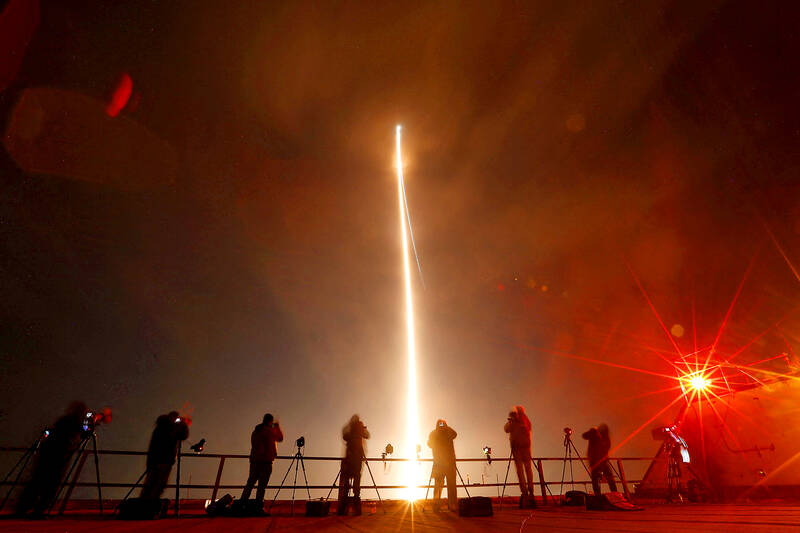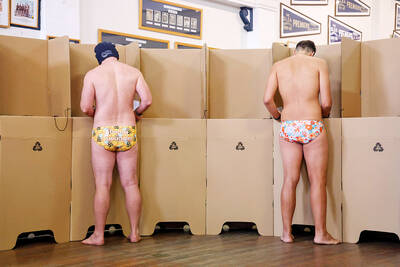The first US lunar lander in more than 50 years yesterday rocketed toward the moon, launching private companies on a space race to make deliveries for NASA and other customers.
Astrobotic Technology’s lander caught a ride on a brand new rocket, United Launch Alliance’s Vulcan. The Vulcan streaked through the Florida predawn sky, putting the spacecraft on a roundabout route to the moon that should culminate with an attempted landing on Feb. 23.
The Pittsburgh, Pennsylvania, company aims to be the first private business to successfully land on the moon, something only four countries have accomplished.

Photo: Reuters
However, a Houston company also has a lander ready to fly, and could beat it to the lunar surface, taking a more direct path.
“First to launch. First to land is TBD,” (to be determined), Astrobotic chief executive John Thornton said.
NASA gave the two companies millions to build and fly their own lunar landers. The space agency wants the privately owned landers to scope out the place before astronauts arrive, while delivering NASA tech and science experiments as well as odds and ends for other customers.
Astrobotic’s contract for the Peregrine lander: US$108 million.
The last time the US launched a moon-landing mission was in December 1972. Apollo 17’s Gene Cernan and Harrison Schmitt became the 11th and 12th men to walk on the moon, closing out an era that has remained NASA’s pinnacle.
The space agency’s new Artemis program — named after the twin sister of Apollo in Greek mythology — looks to return astronauts to the moon’s surface within the next few years. First would be a lunar fly-around with four astronauts, possibly before the end of the year.
The Soviet Union and the US racked up a string of successful moon landings in the 1960s and 1970s, before pausing touchdowns. China joined the elite club in 2013 and India last year, when landers from Russia and a private Japanese company slammed into the moon. An Israeli nonprofit crashed in 2019.
The hour-long descent to the lunar surface — by far the biggest challenge — would be “exciting, nail-biting, terrifying all at once,” Thornton said.
Besides flying experiments for NASA, Astrobotic drummed up its own freight business, packing the 1.9m Peregrine lander with everything from a chip of rock from Mount Everest and toy-size cars from Mexico that would catapult to the lunar surface and cruise around, to the ashes and DNA of deceased space enthusiasts, including Star Trek creator Gene Roddenberry and science fiction writer Arthur C. Clarke.
The Navajo Nation last month sought to have the launch delayed because of the human remains, saying it would be a “profound desecration” of a celestial body revered by Native Americans.
Thornton said the objections came too late, but promised to try to find “a good path forward” with the Navajo for future missions.
One of the spaceflight memorial companies that bought room on the lander, Celestis, said in a statement that no single culture or religion owns the moon and should not be able to veto a mission.
More remains are on the rocket’s upper stage, which, once free of the lander, would indefinitely circle the sun as far out as Mars.
Cargo fares for Peregrine ranged from a few hundred dollars to US$1.2 million per kilogram, not nearly enough for Astrobotic to break even.
For this first flight, that is not the point, Thornton said.
“A lot of people’s dreams and hopes are riding on this,” he said.

Kehinde Sanni spends his days smoothing out dents and repainting scratched bumpers in a modest autobody shop in Lagos. He has never left Nigeria, yet he speaks glowingly of Burkina Faso military leader Ibrahim Traore. “Nigeria needs someone like Ibrahim Traore of Burkina Faso. He is doing well for his country,” Sanni said. His admiration is shaped by a steady stream of viral videos, memes and social media posts — many misleading or outright false — portraying Traore as a fearless reformer who defied Western powers and reclaimed his country’s dignity. The Burkinabe strongman swept into power following a coup in September 2022

‘FRAGMENTING’: British politics have for a long time been dominated by the Labor Party and the Tories, but polls suggest that Reform now poses a significant challenge Hard-right upstarts Reform UK snatched a parliamentary seat from British Prime Minister Keir Starmer’s Labor Party yesterday in local elections that dealt a blow to the UK’s two establishment parties. Reform, led by anti-immigrant firebrand Nigel Farage, won the by-election in Runcorn and Helsby in northwest England by just six votes, as it picked up gains in other localities, including one mayoralty. The group’s strong showing continues momentum it built up at last year’s general election and appears to confirm a trend that the UK is entering an era of multi-party politics. “For the movement, for the party it’s a very, very big

ENTERTAINMENT: Rio officials have a history of organizing massive concerts on Copacabana Beach, with Madonna’s show drawing about 1.6 million fans last year Lady Gaga on Saturday night gave a free concert in front of 2 million fans who poured onto Copacabana Beach in Rio de Janeiro for the biggest show of her career. “Tonight, we’re making history... Thank you for making history with me,” Lady Gaga told a screaming crowd. The Mother Monster, as she is known, started the show at about 10:10pm local time with her 2011 song Bloody Mary. Cries of joy rose from the tightly packed fans who sang and danced shoulder-to-shoulder on the vast stretch of sand. Concert organizers said 2.1 million people attended the show. Lady Gaga

SUPPORT: The Australian prime minister promised to back Kyiv against Russia’s invasion, saying: ‘That’s my government’s position. It was yesterday. It still is’ Left-leaning Australian Prime Minister Anthony Albanese yesterday basked in his landslide election win, promising a “disciplined, orderly” government to confront cost-of-living pain and tariff turmoil. People clapped as the 62-year-old and his fiancee, Jodie Haydon, who visited his old inner Sydney haunt, Cafe Italia, surrounded by a crowd of jostling photographers and journalists. Albanese’s Labor Party is on course to win at least 83 seats in the 150-member parliament, partial results showed. Opposition leader Peter Dutton’s conservative Liberal-National coalition had just 38 seats, and other parties 12. Another 17 seats were still in doubt. “We will be a disciplined, orderly